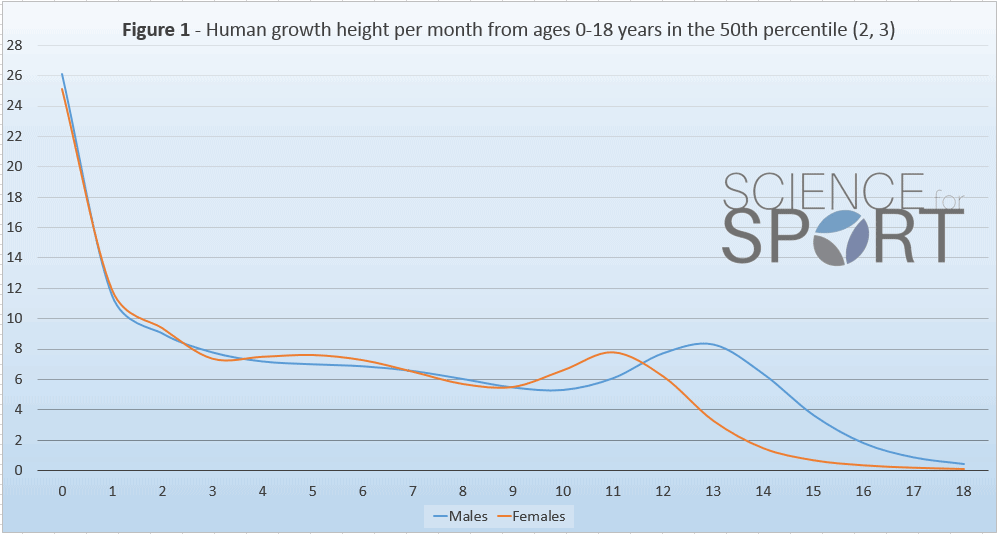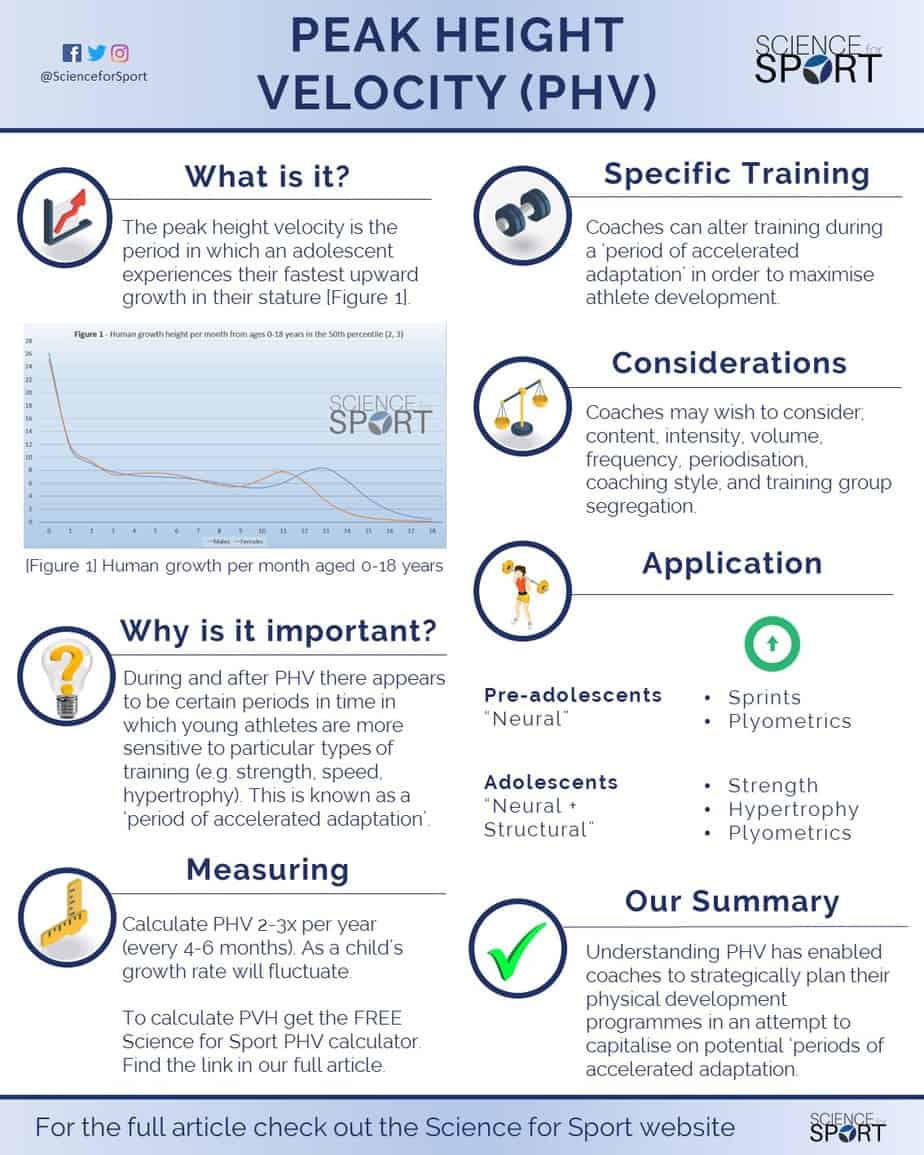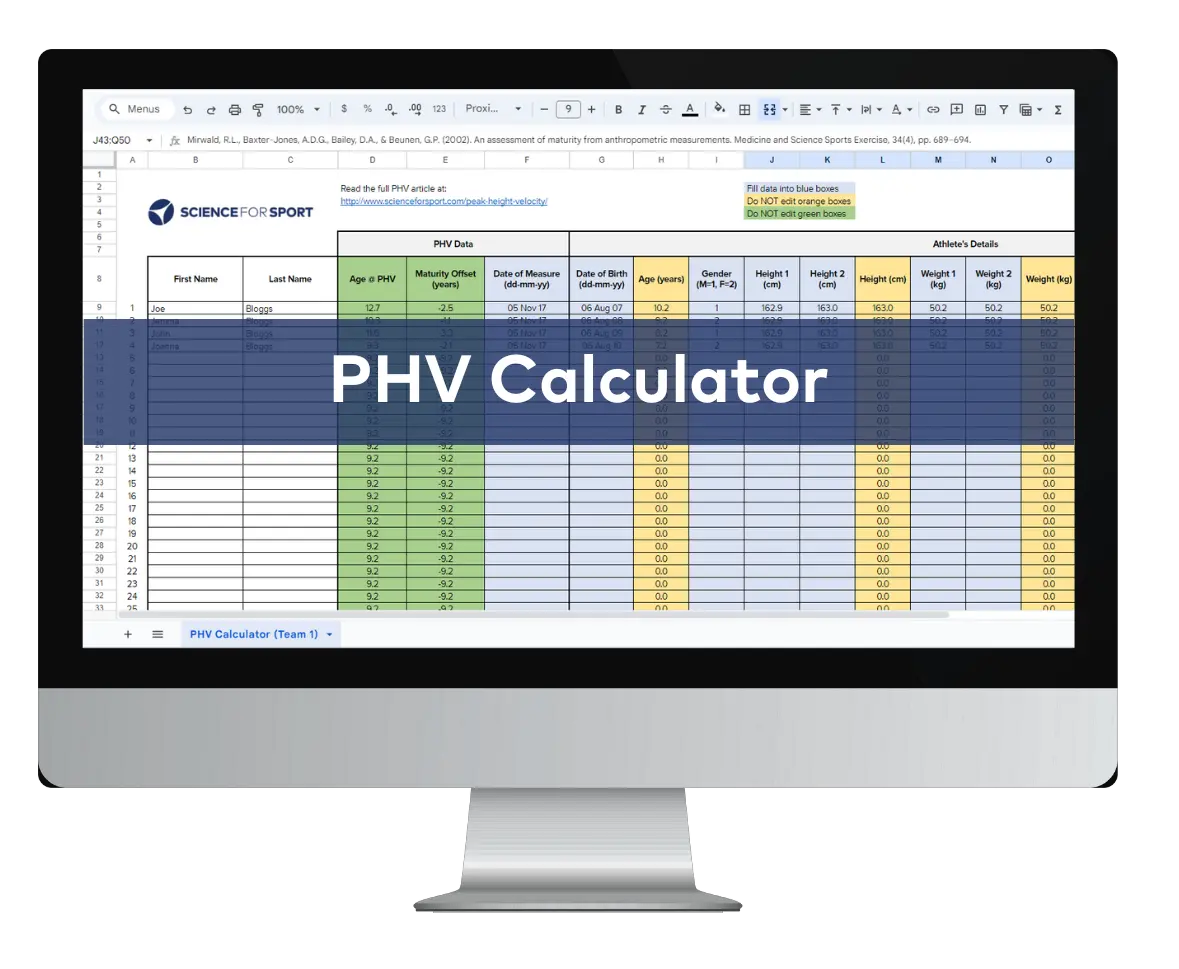Contents of Article
- Summary
- Introduction and key terms
- What is Peak Height Velocity (PHV)?
- What age does Peak Height Velocity occur?
- What causes Peak Height Velocity?
- Why is Peak Height Velocity important for athletic development?
- How do you measure Peak Height Velocity?
- Is Peak Height Velocity testing valid and reliable?
- Is more research on Peak Height Velocity needed?
- How often should Peak Height Velocity be tested?
- Conclusion
- References
- About the Author
Summary
Peak height velocity (PHV) is simply the period of time in which an adolescent experiences the fastest upward growth in their stature (i.e. the time when they grow the fastest during their adolescent growth). Females appear to experience the onset of the adolescent growth spurt and PHV earlier than males, though males appear to grow more during this period.
The maturity offset can be used to calculate a child’s age of PHV, which is commonly used by strength and conditioning coaches and sports scientists to adapt their training prescription. Thus, understanding PHV and monitoring your athletes’ maturity offset (age of PHV) is highly encouraged. It is also recommended that the maturity offset be calculated approximately 2-3 times per year.

Introduction
In recent years, youth strength training has experienced a significant rise in interest (1). This is perhaps for multiple reasons such as increased sporting focus on young athletes, improved understanding of the safety and physical potential of youth strength training, and new sales avenues for profitable businesses.
Regardless of the reasons which surround the increased interest, what is truly important is how to maximise the physical potential of youths whilst maintaining or even improving safe practices to protect their health and wellbeing. As a result, many protocols have been developed in order to monitor development and enhance athleticism both safely and effectively – one of which is the use of the maturity offset.
Key terms:
- Infant – baby or very young child (0-2 years).
- Child/pre-adolescent – from 2 years old to the onset of puberty (approximately 11.5-13.5 years).
- Adolescent – from the onset of puberty to the end of pubertal growth (approximately 18 years).
What is Peak Height Velocity?
PHV is simply the period of time in which a child experiences the fastest upward growth in their stature – i.e. the time when they grow the fastest during their adolescent growth spurt (1). This is often confused with peak weight velocity, but these two things are not the same.
A common misconception is that humans experience their fastest vertical growth during the adolescent growth spurt, this, however, is incorrect. The fastest increase in stature is actually observed during the first year of life, after birth (Figure 1). During this period (0-1 year), the average male grows approximately 26cm per year, whilst the average female grows approximately 25cm, respectively (2).
During the adolescent growth spurt (i.e. PHV), the average male typically achieves a PHV of approximately 8.3cm, and females approximately 7.8cm (3). This data is based on the 50th percentile (i.e. average) of youths within the United States of America and is extracted from the statistics provided by the Centre of Disease Control (2, 3). Other reports have suggested that growth in the normal female averages 9cm/yr and varies normally from 5.4 to 11.2cm. Whilst the normal male averages 10.3cm/yr and varies normally from 5.8 to 13.1cm (4)
Regardless of the growth rates during the first year of life, the adolescent growth spurt (adolescent PHV) is the most important for the exercise professional. Note that Figure 1 also displays the onset of the adolescent growth spurt in both males and females – represented by the sudden rise in growth velocity.
What age does Peak Height Velocity occur?
According to the latest statistics from the Royal College of Paediatrics and Child Health, and based on the 50th percentile of youths, both the onset of the adolescent growth spurt (which coincides with the onset of puberty) and the onset of PHV occurs earlier in females (approximately 11 years of age) than in males (approximately 13 years of age) (3,5). Although males typically experience a later onset of PHV, the magnitude of this growth spurt is often greater than that of females (6). This simply implies that males will grow more during the adolescent growth spurt than females.
What causes Peak Height Velocity?
As previously mentioned the onset of the adolescent growth spurt coincides with the onset of puberty (5). Many of the body’s hormones influence growth, such as growth hormone, thyroxine, insulin, corticosteroids (all of which influence growth rate), leptin (which alters body composition), and parathyroid hormone, 1,25-dihydroxy-vitamin D, and calcitonin (all of which affect skeletal mineralisation). However, the key hormone in growth is growth hormone, which is mediated by growth hormone-releasing hormone (GHRH) and somatostatin (SS) (7).
As a result, the athletic performance improvements observed at the onset, during, and after the adolescent growth spurt are caused by maturity-related changes (1). These changes may include:
- ↑ androgen concentrations (8)
- ↑ fibre-type differentiation (8)
- ↑ resting adenosine trisphosphate (8)
- ↑ creatine phosphate levels (8)
- Architectural development of the muscle-tendon units (8).
Why is Peak Height Velocity important for athletic development?
Before, during, and after PHV there appear to be certain periods of time in which young athletes are more sensitive to particular types of training (e.g. strength, speed, hypertrophy) (9). These time periods have previously been referred to as ‘windows of opportunity’ (10), though this term has caused some degree of turmoil amongst exercise scientists as it implies these opportunities can be missed, thus suggesting athletes may miss a vital opportunity to maximise their athletic potential. It also suggests there is a ceiling for athletic potential, and if these windows are missed, then that ceiling may be lower than if they were to train throughout that time.
Put simply, it suggests that athletes who exploit these ‘windows of opportunity’ have a higher ceiling for their athletic potential than those who do not – though this does not appear to be true (1). Consequently, this has led to the development of the term ‘periods of accelerated adaptation’ (1), as this suggests these time periods are simply opportunities for athletes to make greater improvements in athleticism than otherwise possible. These periods of accelerated adaptation have many implications for training programme design, including training content, intensity, volume, frequency, periodisation, coaching style, and training group segregation.
Therefore, it is believed that calculating a child’s onset of PHV can enable the strength and conditioning coach or sports scientist to tailor the training programme in synchronisation with the athlete’s biological age as opposed to their chronological age – this may result in a better suited and more effective training programme (1). For example, evidence has suggested pre-adolescents benefited most from training modes that require a high-levels of neural activation (sprint training and plyometrics), whereas adolescents responded better to training types that target both neural and structural development (strength training and plyometrics) (11).
It is also relatively well-understood that adolescents respond more favourably to muscle hypertrophy training than preadolescents due to the higher concentrations of certain hormones – namely testosterone and growth hormone (12, 13). Furthermore, upon the onset of the adolescent growth spurt, boys typically experience greater maturational improvements in all aspects of fitness than girls (e.g. strength and power) – except for flexibility (14). Providing these ‘periods of accelerated adaptation’ truly exist, they would help sports scientists to maximise the physical capacity/potential of their athletes.
Though this information expresses some of the primary factors associated with the PHV and its importance to athletic development, it does not discuss how training should be manipulated in order to optimise athletic development. For a more in-depth discussion on that topic then we’d recommend you read our article on youth strength training.
How do you measure Peak Height Velocity?
The age at which a child is expected to achieve PHV can be calculated using the ‘maturity offset’ value. In other words, the maturity offset allows you to predict what age the child will achieve PHV. There are several ways to measure a child’s maturity offset, however, some require either genital assessment or radiography (i.e. x-rays). Consequently, a simple and non-invasive method for predicting physical maturation has been developed (15). This method of calculating the maturity offset can be completed by recording the following information:
- Gender
- Date of Birth
- Date of Measurement
- Standing Height (cm)
- Sitting Height (cm)
- Weight (kg)
Note: The accuracy of these measures is of utmost importance, any errors will drastically affect the precision of the prediction. A detailed description of the accurate measurement protocols can be found in our PHV calculator & guidelines. This calculator allows you to simply and accurately calculate the maturity offset using the calculations produced by Mirward et al., (2002) (15).
In addition to PHV, skeletal age and peak weight velocity are also reliable and non-invasive methods to calculate physical maturation (1, 16).
In a practical setting, paediatric sports scientists will often use a calculation of an individual’s age of PHV (maturity offset) as this provides an accurate benchmark as to how long the individual is from experiencing their PHV. For example, if a 13-year-old male’s age of PHV is calculated at 13 years and four months, then the exercise scientist can begin to plan for this forthcoming physical change. The prediction of how far an individual is from their age of PHV is based on the different timing and growth rates of leg length and sitting height. That being, leg length grows first, shortly followed by sitting height growth.
The closer the individual is to experiencing PHV, the more accurate the prediction. Consequently, the ideal age of prediction is 9-13 years in females and 12-16 years in males (17). When predicting the maturity offset of the individual, note that a negative value suggests the process has not started yet, whilst a positive value implies that it has already begun. For instance, any negative figure such as -3.4 implies that the child is 3.4 years away from their predicted age of PHV.
Is Peak Height Velocity testing valid and reliable?
A 2002 investigation by Mirwald and colleagues (15) determined that measuring the maturity offset (age of PHV) using all variables previously discussed provides a valid and reliable prediction of the maturity offset. Having said this, to produce reliable results, the test administrator must adhere to strict measurement protocols as any inconsistencies can impact the test results.
Thus, we have developed a testing procedure document and calculation workbook to enable you to safely and accurately calculate the maturity offset with ease.
Is more research on Peak Height Velocity needed?
Knowing the importance of PHV on athletic development, it is suggested that additional research regarding the training adaptations around the period of PHV needs much further exploration. For example, is there a ‘period of accelerated adaptation’ for aerobic development during the onset of PHV?
Other questions to consider may include:
- Are there speed, strength, and power development ‘periods of accelerated adaptation’ surrounding the period of PHV?
- Are there aerobic and/or anaerobic ‘periods of accelerated adaptation’ surrounding the period of PHV?
- Are there significant differences in the rate at which physical development occurs between genders surrounding the period of PHV?
How often should Peak Height Velocity be tested?
Although this PHV prediction has been shown to possess significant reliability, it has been shown to be most reliable when conducted within one year of PHV (15). Consequently, it may be recommended that professionals assess their athlete’s age of PHV multiple times throughout the year in order to have a prediction that is as reliable as possible. For example, professionals may complete this prediction 2-3 times per year (every 4-6 months). It is important to note that a child’s growth rate fluctuates throughout the year, this may, therefore, make continual maturity offset testing somewhat needless – hence the rationale for testing 2-3 times maximum per year.
Conclusion
Since its creation in 2002 by Robert Mirwald and his colleagues (15), the assessment of maturity (age of PHV predictor) has helped paediatric exercise specialists advance their strength and conditioning practices by understanding their athletes’ current and forthcoming physicality. Understanding this has enabled them to strategically plan their physical development programmes in an attempt to capitalise on potential ‘periods of accelerated adaptation’.
Needless to mention that utilising potential periods of accelerated adaptation may lead to enhanced athleticism in young athletes.
- Lloyd, R.S., and Oliver, J.L. (2012). The Youth Physical Development Model: A New Approach to Long-Term Athletic Development. Strength and Conditioning Journal, 34(3), pp.61-72. [Link]
- Growth Charts – Data Table of Infant Length-for-age Charts. 2001. Growth Charts – Data Table of Infant Length-for-age Charts. [ONLINE] Available at: [Link]. [Accessed 07 February 2016].
- UK-WHO growth charts – 2-18 years [ONLINE] Available at: [Link]. [Accessed 23 March 2024].
- Neinstein LS and Kaufman FR, chapter 1: Normal Physical Growth and Development from Neinstein L.S. Adolescent Health Care: A Practical Guide, 4th edition, Lippincott Williams and Wilkins 2002. [Link]
- Rogol AD, Clark PA, Roemmich JN. Growth and pubertal development in children and adolescents: effects of diet and physical activity. Am J Clin Nutr. 2000 Aug;72(2 Suppl):521S-8S. [PubMed]
- Beunen, G.P. and Malina, R.M. (1988). Growth and physical performance relative to the timing of the adolescent spurt. Exercise and Sport Science Review, 16: pp.503–540. [PubMed]
- Hannaman, A. (2003). Adolescent Health Care: A Practical Guide, 4th Edition. Lippincott Williams & Wilkins: USA. [Link]
- Myer GD, Faigenbaum AD, Ford KR, Best TM, Bergeron MF, and Hewett TE. When to initiate integrative neuromuscular training to reduce sport-related injuries and enhance health in youth. Curr Sports Med Rep 10: 157–166, 2011. [PubMed]
- Ford, P., De Ste Croix, M., Lloyd, R., Meyers, R., Moosavi, M., Oliver, J., Till, K., & Williams, C. (2011). ‘The Long-Term Athlete Development model: Physiological evidence and application’, Journal of Sports Sciences, 29(4), pp.389-402. [PubMed]
- Balyi I and Hamilton A. Long-Term Athlete Development: Trainability in Childhood and Adolescence—Windows of Opportunity—Optimal Trainability. Victoria, Canada: National Coaching Institute British Columbia & Advanced Training and Performance Ltd, 2004. [Link]
- Rumpf MC, Cronin JB, Oliver JL, and Hughes MG. Effect of different training methods on running sprint times in male youth. Pediatr Exerc Sci. 2012. [PubMed]
- Malina RM, Bouchard C, and Bar-Or O. Growth, Maturation, and Physical Activity. Champaign, IL: Human Kinetics, 2004. pp. 41–77. [Link]
- Viru, A., Loko, J., Harro, M., Volver, A., Laaneaots, L., and Viru, M. (1999). Critical periods in the development of performance capacity during childhood and adolescence. European Journal of Physical Education, 4: pp.75–119. [Link]
- Beunen, G.P. and Malina, R.M. (2005). Growth and biological maturation: Relevance to athletic performance. In: The Child and Adolescent Athlete. Bar-Or O, ed. Oxford, United Kingdom: Blackwell Publishing, pp. 3–17. [Link]
- Mirwald, R.L., Baxter-Jones, A.D.G., Bailey, D.A., & Beunen, G.P. (2002). An assessment of maturity from anthropometric measurements. Medicine and Science Sports Exercise, 34(4), pp. 689–694. [PubMed]
- Malina R.M. (2011). Skeletal age and age verification in youth sport. Sports Med, 41, pp.925–47. [PubMed]
- Prediction of Age of Peak Height Velocity – University of Saskatchewan. 2015. Prediction of Age of Peak Height Velocity – University of Saskatchewan. [ONLINE] Available at: [Link]. [Accessed 04 December 2015].






